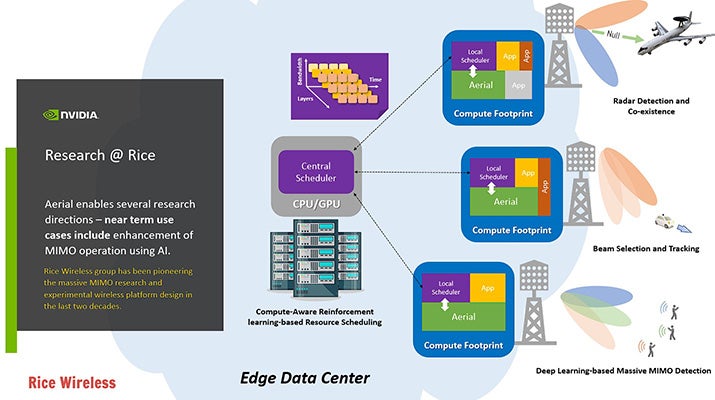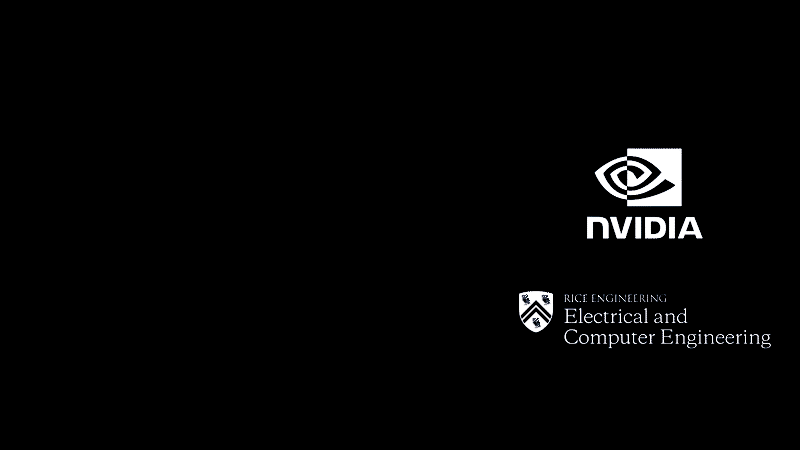Rice Electrical and Computer Engineering (ECE) researchers Rahman Doost-Mohammady, Ashutosh Sabharwal, and Santiago Segarra, members of the Rice Wireless group, are collaborating with NVIDIA on the application of artificial intelligence (AI) in accelerating the performance of 5G cellular networks. NVIDIA has recently released its Aerial Research Cloud platform, which in conjunction with the OpenAirInterface Software Alliance software provides a full-stack private 5G+ base station and Core [1], with access to the source. This platform operates on NVIDIA GPUs and can connect commercial 5G cell phones. It also features MU-MIMO capabilities, where the base station can transmit and receive multiple mobile phones simultaneously.
With two decades of experience at Rice Wireless in building experimental wireless platforms and testbeds, we are in a unique position to innovate in the next generation of wireless using AI. Our collaboration with NVIDIA will give us a big boost in that direction, said Ashutosh Sabharwal, Rice ECE chair and Ernest D. Butcher Professor of ECE.
Rice is one of the early adopter institutions of the NVIDIA Aerial Research Cloud platform due to its longstanding relationship with NVIDIA. Rice Wireless has been working in recent years on rethinking the architecture of many-antenna communication systems, dubbed as massive MIMO using AI techniques. Rice is one of the pioneers of massive MIMO research and has been building a massive MIMO wireless testbed of its own as part of the NSF-funded RENEW project. It has also worked on the use of AI in wireless through multiple NSF-funded projects, such as 3DML.

The NVIDIA Aerial Research Cloud platform will be a game changer in enabling “AI in Wireless” research as it provides researchers with a direct and easy path to prototype their ideas into action. The Rice Wireless group is happy to take its research efforts to the next step by implementing its novel research on the Aerial Research Cloud to demonstrate much better performance in MU-MIMO communication. In addition, the group is pursuing multiple directions in using the Aerial platform which has been described in more detail in this blog post.
One of the biggest challenges in using AI to enhance connectivity in wireless networks is the large computational complexity of AI models. The NVIDIA Aerial Research Cloud platform gives us an exciting opportunity to use the power of NVIDIA GPUs to run those AI models as efficiently as possible, said Rahman Doost-Mohammady, Assistant Research Professor of ECE.
Rice’s collaboration with NVIDIA on augmenting the capabilities of the Aerial platform with AI techniques will be featured in the “A Bridge to 6G - Aerial Research Cloud” session at NVIDIA GTC on March 23rd. You can learn about this event on this page. GTC brings together many researchers and developers from both academia and industry, working on the applications of AI in various domains, and includes many talks and demonstrations by experts in those fields.
Sabharwal earned his Ph.D. in electrical engineering from Ohio State University in 1999 and joined the Rice faculty that year. His work in wireless is in two distinct research areas: fundamental principles and novel experimental platforms for advanced wireless networking.
Doost-Mohammady earned his PhD in Computer Engineering from Northeastern University in 2015. He joined the Rice faculty in January 2020 and serves as the technical lead for the RENEW project. His research interests include wireless systems and networking and mobile computing. 2015, PhD in Computer Engineering, Northeastern University
Segarra, W. M. Rice Trustee Faculty Chair and Assistant Professor of ECE, received his M.Sc. in Electrical Engineering and his Ph.D. in Electrical and Systems Engineering from the University of Pennsylvania, Philadelphia, in 2014 and 2016 respectively. He joined the Rice faculty in July of 2018 and his research interests include data science for networks; modeling, analysis, and design of networked systems; signal processing, machine learning, optimization, and algebraic topology applied to the understanding of networks and network data
[1] https://openairinterface.org/news/osa-announces-its-participation-in-2023-nvidia-gtc/

